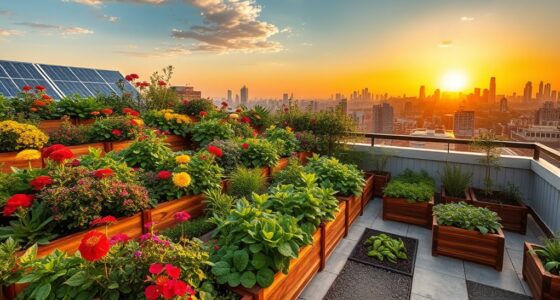Creating an indoor herb haven on your kitchen counter is easy and rewarding. You’ll enjoy fresh, fragrant herbs year-round, making cooking more vibrant and convenient. Use proper watering techniques, like checking soil moisture and avoiding overwatering, to keep your herbs healthy. Incorporate natural pest prevention, good airflow, and appropriate lighting to promote thriving plants. With some simple automation and fertilization tips, your countertop garden will flourish—learn more to maximize your herb growing success.
Key Takeaways
- Select compact, attractive herbs like basil, parsley, and thyme for easy countertop placement.
- Use self-watering pots or moisture sensors to maintain optimal soil hydration effortlessly.
- Ensure ample indirect light or grow lights to promote healthy herb growth and prevent pests.
- Implement good airflow and avoid overcrowding to reduce disease and pest risks.
- Regularly fertilize with diluted organic solutions to support lush, flavorful herbs year-round.

Indoor herb gardening is a rewarding way to enjoy fresh flavors year-round, even if you don’t have outdoor space. Setting up a small herb garden on your kitchen counter allows you to harvest fragrant herbs whenever you need them, making cooking more vibrant and enjoyable. To keep your herbs thriving, you need to master basic care techniques, starting with watering. Proper watering techniques are essential; overwatering can lead to root rot, while underwatering causes herbs to wilt and lose flavor. A good rule of thumb is to check the top inch of soil—if it feels dry, it’s time to water. Use a watering can with a narrow spout to direct water at the base of the plants, avoiding the leaves to prevent fungal issues. Consistent, moderate watering encourages healthy growth and ensures your herbs stay lush. Incorporating automation in business and technology into your gardening routine, such as self-watering pots or moisture sensors, can help maintain optimal soil moisture levels more efficiently. Beyond watering, pest control methods are vital to maintaining a healthy indoor herb garden. Indoor environments can sometimes be prone to pests like aphids, spider mites, or whiteflies, which can quickly damage your plants. The first step is prevention—keeping your herbs healthy and well-maintained reduces the risk of infestations. Regularly inspect your plants for signs of pests, such as discolored or deformed leaves. If pests appear, start with natural methods like spraying a mixture of water and a few drops of dish soap directly onto affected areas. Neem oil is also effective as a natural pesticide; it’s safe for edible plants and helps control pests without harmful chemicals. Remove any heavily infested leaves immediately to prevent pests from spreading further. Good airflow and proper lighting play a role in pest prevention too. Crowded or poorly lit conditions can encourage pest problems because they weaken plant defenses. Make sure your herbs aren’t too crowded, and place your containers where they receive ample indirect sunlight or grow lights. Proper lighting also keeps your herbs healthy and flavorful, reducing their susceptibility to pests. Lastly, avoid over-fertilizing, which can make plants more attractive to pests. Stick to a balanced, diluted organic fertilizer every few weeks to support healthy growth.
Frequently Asked Questions
Which Herbs Grow Best in Low-Light Indoor Conditions?
If you’re wondering which herbs grow best in low-light indoor conditions, you’ll want to explore low light herb options like mint, parsley, chives, and oregano. These herbs thrive with minimal indoor herb lighting, making them perfect for shaded spots. To support their growth, guarantee you place them near indirect light or provide supplemental grow lights. With proper care, you’ll enjoy fresh herbs even in dimly lit spaces.
How Often Should Indoor Herbs Be Watered?
Think of your indoor herbs as thirsty singers waiting for their cue; their watering frequency depends on their specific needs. To keep them thriving, you should check the soil’s moisture regularly, aiming for ideal moisture—not too soggy, not too dry. Typically, watering once a week works for most, but adjust based on your home’s humidity and the herb’s growth stage. Stay attentive, and your herbs will flourish in harmony.
Can I Grow Herbs Without Using Soil?
Yes, you can grow herbs without soil through soil-free cultivation methods like hydroponic gardening. This technique involves growing herbs in nutrient-rich water solutions, which provides direct access to essential nutrients and often leads to faster growth. Hydroponic gardening is ideal for indoor environments, allowing you to cultivate fresh herbs on your kitchen counter without dealing with soil messes or pests. It’s a smart, space-efficient way to enjoy herbs year-round.
What Are Common Pests for Indoor Herbs?
You want to know about common pests for indoor herbs. Pest identification is key to managing issues early. Common pests include aphids, spider mites, and whiteflies. To keep your herbs healthy, use organic pest control methods like neem oil or insecticidal soap, which are safe and effective. Regularly inspect your plants, and act promptly to prevent infestations from spreading, ensuring your indoor herbs thrive.
How Do I Prevent Herbs From Flowering Prematurely?
Prevent premature flowering with proper pruning techniques and careful harvesting timing. Regularly pinch back young flower buds to keep herbs focused on leaf growth. By consistently pruning, you encourage lush, full foliage and delay flowering. Harvest herbs early, before buds form, to maintain flavor and vigor. Staying attentive to your herbs’ growth cycle helps you control flowering, ensuring a plentiful, flavorful harvest while keeping your indoor garden thriving and vibrant.
Conclusion
Now that you’ve turned your kitchen counter into a lush herb haven, you’ve sown the seeds of freshness right at your fingertips. With a little care, these herbs will flourish like a well-tuned orchestra, filling your home with aroma and flavor. Remember, your indoor garden is a living reminder that even small spaces can grow big things. Nurture it, and watch your culinary world bloom — proving that with patience, your space becomes a garden of endless possibilities.









